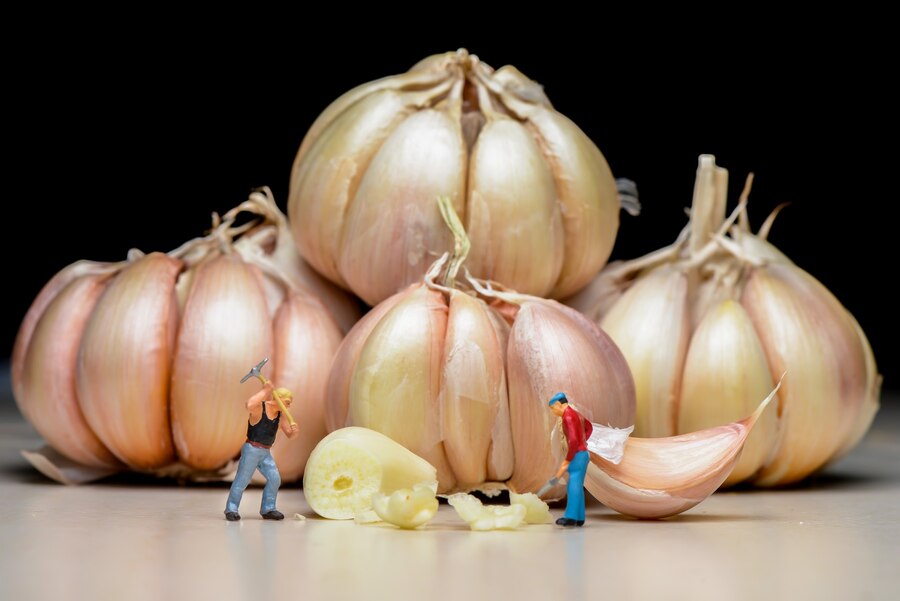The global garlic export business has been steadily growing, driven by rising consumer demand for this versatile ingredient. Garlic, known for its culinary uses and health benefits, has found its place in kitchens and healthcare markets across the globe. With the increasing interest in plant-based diets, natural health remedies, and international cuisines, the garlic export market is expected to grow significantly in the coming years. In this article, we explore the global garlic export business growth potential for 2024, looking at market trends, key players, challenges, and opportunities.
Introduction to the Global Garlic Export Market
Garlic is one of the oldest cultivated plants in the world. It is native to Central Asia but is now grown in various regions across the globe. The primary use of garlic is in the culinary industry, where it enhances the flavor of dishes. However, garlic also has medicinal properties, contributing to its expanding use in the pharmaceutical and wellness industries.
According to a report by MarketsandMarkets, the garlic market is expected to grow at a compound annual growth rate (CAGR) of 3.7% from 2024 to 2029. The market’s growth is driven by factors such as the increasing demand for garlic-based food products, rising awareness about its health benefits, and the expansion of garlic production in key exporting countries.
Global Garlic Market Size and Demand
The global garlic export market is valued at billions of dollars, with China leading the way as the largest producer and exporter. In 2023 alone, global garlic exports were valued at over $10 billion. This growth can be attributed to the rise in demand from both developing and developed countries. Garlic’s applications extend beyond traditional food use, as it is now widely included in health supplements, cosmetics, and functional foods.
The demand for garlic has expanded in regions like the Middle East, Southeast Asia, and North America, which increasingly value its health benefits and culinary versatility. As consumers lean towards more plant-based and natural food options, garlic continues to gain traction.
Key Exporting Countries
1. China:
China is by far the largest producer and exporter of garlic, accounting for nearly 80% of the global garlic export volume. The country’s favorable climate, large-scale agricultural production, and established export infrastructure have contributed to its dominance in the garlic export market.
2. India:
India is another major garlic exporter, although its export volume is significantly smaller than China’s. The country’s garlic production is mostly concentrated in the northern and western states. India’s export potential is growing as demand for its high-quality garlic, often used in spice mixes and health products, continues to increase.
3. Spain:
Spain is the leading European garlic exporter, particularly supplying the European Union with fresh garlic. Spain’s garlic industry is well-organized, and the country is known for its high-quality varieties, such as the “Morado” garlic. Spain is also increasingly targeting international markets outside the EU.
4. Argentina:
Argentina is one of the top garlic producers in South America. The country has a growing garlic export business, primarily focused on the North American and European markets. Argentina’s garlic is particularly known for its organic production methods, which appeal to health-conscious consumers.
5. Egypt:
Egypt is rapidly emerging as a strong contender in the global garlic export market. With favorable growing conditions and significant investments in agricultural technology, Egypt is expected to continue increasing its export share in the coming years.
Global Garlic Export Trends in 2024
The global garlic export business growth potential in 2024 is influenced by several key trends:
1. Increasing Demand for Organic Garlic
As consumers become more health-conscious, the demand for organic products, including organic garlic, is on the rise. Organic garlic is free from pesticides and chemical fertilizers, making it an attractive choice for health-focused consumers. This trend is particularly strong in North America and Europe.
2. Garlic-Based Products on the Rise
Garlic’s versatility is driving the growth of garlic-based products such as garlic paste, garlic oil, and garlic powder. These products are convenient, have longer shelf lives, and are widely used in various cuisines. The market for garlic supplements is also expanding, with garlic touted for its cardiovascular and immune-boosting properties.
3. E-commerce and Direct-to-Consumer Sales
The rise of e-commerce has made it easier for garlic exporters to sell directly to consumers. Online platforms allow exporters to reach a global audience, bypassing traditional distribution channels. This shift is particularly significant in markets like the United States, where consumers increasingly prefer to purchase products online.
4. Sustainability and Traceability
Consumers are increasingly interested in the sustainability and traceability of the products they purchase. Garlic producers and exporters are adopting more sustainable farming practices and transparent supply chains to meet this demand. Certifications such as Fair Trade and organic labels are gaining importance in the garlic export market.
5. Export Restrictions and Supply Chain Challenges
Despite the growth potential, the garlic export business faces challenges, particularly regarding supply chain disruptions and trade restrictions. In 2024, geopolitical factors and global inflation could impact the garlic export market. For instance, China’s dominance in garlic production could be affected by trade tensions, and labor shortages in some countries could lead to production delays.
Global Garlic Export Statistics by Country (2023)
| Country | Export Volume (Metric Tons) | Market Share (%) | Main Export Regions | Notable Garlic Varieties |
|---|---|---|---|---|
| China | 2,400,000 | 80% | North America, Europe, Asia | “Shandong,” “Purple Stripe,” “Lao-Gao” |
| India | 250,000 | 8% | Middle East, North America | “Lahore,” “Indian White” |
| Spain | 100,000 | 4% | European Union, North America | “Morado,” “Ajo de Las Pedroñeras” |
| Argentina | 50,000 | 2% | North America, Europe | “White,” “Purple” |
| Egypt | 30,000 | 1.2% | Europe, Asia | “Baladi,” “Alexandria” |
Garlic Export Business Opportunities
The global garlic export business growth potential presents numerous opportunities for both large-scale producers and small-scale exporters. Here are some of the key opportunities in the market:
1. Expanding into Emerging Markets
As the demand for garlic grows in emerging markets such as Africa and Latin America, there is significant potential for garlic exporters to expand into these regions. The increasing adoption of Western diets and growing awareness of garlic’s health benefits are contributing to this trend.
2. Garlic as a Health Ingredient
The growing popularity of natural health products presents an opportunity for garlic exporters to target the wellness sector. Garlic’s reputed health benefits, including its potential to lower cholesterol, improve cardiovascular health, and boost immunity, make it a valuable ingredient in supplements, functional foods, and personal care products.
3. Innovation in Value-Added Products
Exporters can tap into the value-added garlic product market, offering garlic paste, dried garlic, garlic oil, and even garlic-infused cosmetics. The demand for convenient, ready-to-use products continues to rise, particularly in the busy, health-conscious consumer market.
4. Direct-to-Consumer Sales and Online Platforms
The direct-to-consumer model offers a low-cost way to reach global buyers. Garlic exporters can set up online stores, collaborate with e-commerce giants, or even sell on specialized health and wellness platforms. This model eliminates middlemen, making it easier for consumers to access high-quality garlic products.
Challenges in the Garlic Export Business
While the garlic export business shows immense potential, there are several challenges that exporters must address:
1. Price Volatility
Garlic prices can be highly volatile, particularly in major producing countries. This price fluctuation can be attributed to factors such as crop yields, climate conditions, and market demand. Exporters must find ways to mitigate risks, including diversifying supply chains and securing long-term contracts.
2. Competition from Local Producers
As the garlic market grows, competition from local producers in various countries is intensifying. This could affect the market share of major exporters, such as China. Exporters need to differentiate their products by focusing on quality, sustainability, and innovation.
3. Regulatory Compliance
Garlic exporters must adhere to the regulatory requirements of importing countries. These regulations can vary significantly, requiring exporters to stay informed about changing import policies, quality standards, and labeling requirements. Non-compliance can result in delays, fines, or even product rejection.
4. Supply Chain Disruptions
The garlic supply chain is vulnerable to disruptions due to weather events, political instability, and economic factors. Global shipping issues, such as port congestion or rising fuel costs, can increase transportation expenses and lead to delays in product delivery.
Conclusion
The global garlic export business growth potential in 2024 is promising, driven by expanding demand from international markets, the rise of health-conscious consumers, and the growing popularity of garlic-based products. However, the industry must overcome challenges such as price volatility, regulatory complexities, and supply chain disruptions. Exporters who can innovate, meet quality standards, and adapt to changing consumer preferences will be well-positioned to succeed in this thriving market.
For businesses looking to enter the garlic export industry, now is an ideal time to capitalize on the global growth trends. With strategic investments in production, marketing, and distribution, exporters can take advantage of the garlic market’s vast potential and make their mark on the global stage.










